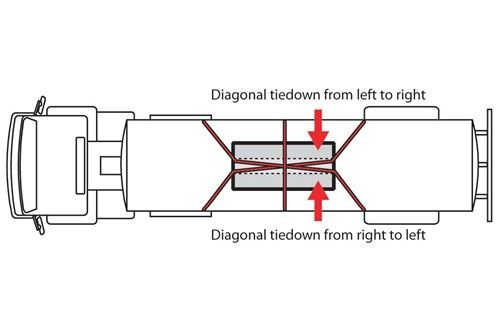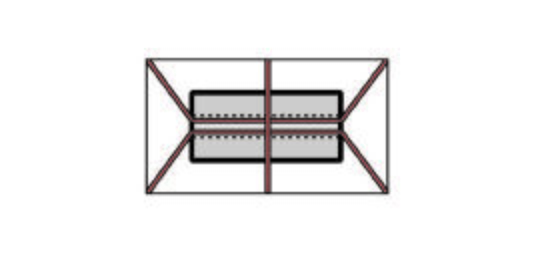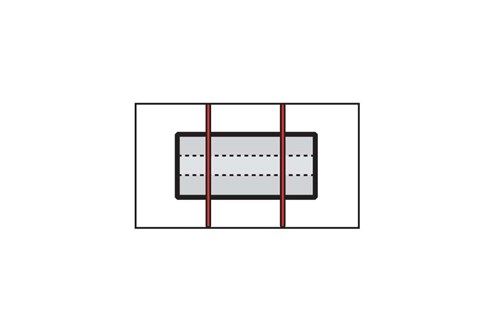Note: Your are not logged in. We can not keep your scores or track your progress unless you Register and Log In
Securing Coils Transported With Eyes Lengthwise on a Vehicle with Anchor Points
Requirements for securing an individual coil

There are three options for safely securing individual coils that are loaded with their eyes lengthwise. Blocking and supporting the coils is the same. The difference is in the tie-down arrangement.
Prevent the coil from rolling
Prevent the coil from rolling by supporting it:
- Timbers, chocks, or wedges held in place by coil bunks or similar devices to prevent them from coming loose.
-
A cradle (for example, two hardwood timbers and two coil bunks) that is restrained from sliding by:
- Friction mats under the cradle.
- Nailed wood blocking or cleats.
- Placing a tie-down around the front of the cradle.
-
The support must:
- Support the coil just above the deck.
- Not become unintentionally unfastened or loose in transit.
The use of nailed blocking or cleats as the sole means to secure timbers, chocks or wedges, or a nailed wood cradle, is prohibited.
Tie-downs, Single Coil Option #1
Attach at least one tie-down diagonally from the left side of the vehicle, through the eye, to the right side of the vehicle. If possible, the angle between the tie-down and the deck should be less than 45, when viewed from the side of the vehicle.
Attach at least one tie-down diagonally from the right side of the vehicle, through the eye, to the left side of the vehicle. If possible, the angle between the tie-down and the deck should be less than 45, when viewed from the side of the vehicle.

Attach at least one tie-down side-to-side over the top of the coil.
Use blocking or friction mats to prevent forward movement.
Tie-downs, Single Coil Option #2
Option #2 is the same as Option #1, except the tie-downs that attach through the eye of the coil are straight instead of diagonal.
Attach at least one tie-down straight from the left side of the vehicle, through the eye, and back to the left side of the vehicle. If possible, the angle between the tie-down and the deck should be less than 45, when viewed from the side of the vehicle.
Attach at least one tie-down straight from the right side of the vehicle, through the eye, and back to the right side of the vehicle. If possible, the angle between the tie-down and the deck should be less than 45, when viewed from the side of the vehicle.

Attach at least one tie-down side-to-side over the top of the coil.
Use blocking or friction mats to prevent forward movement.
Tie-downs, Single Coil Option #3
Option #3 is the same as Options #1 and #2, except that the two tie-downs that attach through the eye of the coil are replaced with two tie-downs that pass over the front and the rear of the coil.

Attach at least one tie-down over the top of the coil near the front of the coil.
Attach at least one tie-down over the top of the coil near the rear of the coil.
Use blocking or friction mats to prevent forward movement.
Multiple-Choice Questions:
When securing metal coils, it is acceptable to use nailed blocking or cleats as the sole means to secure:
- It is not acceptable.
- Nailed wood cradles
- Chocks
- Timbers
The use of nailed blocking or cleats as the sole means to secure timbers, chocks or wedges, or a nailed wood cradle, is prohibited.
Option #1 for securing coils transported with eyes lengthwise includes:
- It should include all of these things
- Attaching at least one tiedown diagonally from the left side of the vehicle, through the eye, to the right side of the vehicle
- Attaching at least one tiedown diagonally from the right side of the vehicle, through the eye, to the left side of the vehicle
- Using blocking or friction mats to prevent forward movement.
Tiedowns, Single Coil Option #1
Attach at least one tiedown diagonally from the left side of the vehicle, through the eye, to the right side of the vehicle. If possible, the angle between the tiedown and the deck should be less than 45, when viewed from the side of the vehicle.
Attach at least one tiedown diagonally from the right side of the vehicle, through the eye, to the left side of the vehicle. If possible, the angle between the tiedown and the deck should be less than 45, when viewed from the side of the vehicle.

Attach at least one tiedown side-to-side over the top of the coil.
Use blocking or friction mats to prevent forward movement.
Option #3 for securing metal coils transported with eyes lengthwise includes all of the following except:
- Attaching at least one tiedown over the top of the coil near the front of the coil.
- Using blocking or friction mats to prevent forward movement.
- Attaching at least one tiedown over the top of the coil near the rear of the coil.
- Attaching at least two tiedowns through the center of the coil.
Tiedowns, Single Coil Option #3
Option #3 is the same as Options #1 and #2, except that the two tiedowns that attach through the eye of the coil are replaced with two tiedowns that pass over the front and the rear of the coil.

Attach at least one tiedown over the top of the coil near the front of the coil.
Attach at least one tiedown over the top of the coil near the rear of the coil.
Use blocking or friction mats to prevent forward movement.
Complete!
You can Return To The Table Of Contents







 TT On Facebook
TT On Facebook